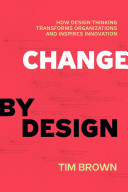

Design thinking is a human-centered approach to innovation that draws from the designer's toolkit to integrate the needs of people, the possibilities of technology, and the requirements for business success. The book emphasizes how design thinking can be applied beyond traditional design fields, impacting business strategy and operations. It encourages organizations to develop empathy for their users, understanding their needs and experiences deeply. This process involves extensive user research, prototyping, and iterative testing, allowing teams to explore a wide range of solutions before arriving at the best one. This iterative cycle not only fosters creativity but also minimizes the risks associated with launching new products or services.
Continue readingEmpathy is a cornerstone of design thinking, allowing designers to step into the users' shoes and understand their experiences and emotions. The book illustrates how empathy can lead to more meaningful and relevant solutions. By observing users in real-life contexts, designers can uncover insights that may not be apparent through traditional market research methods. This deep understanding informs the design process, ensuring that the solutions developed are not only functional but also resonate with users on a personal level. The author shares various case studies demonstrating how empathy-driven design has led to successful innovations.
Continue readingChange by Design highlights the importance of collaboration in the design process. It argues that diverse teams bring a variety of perspectives that can lead to more innovative solutions. The book discusses the dynamics of effective teamwork, emphasizing the need for open communication, trust, and a culture that encourages experimentation. It also addresses the challenges teams may face, such as conflicts or differing opinions, and provides strategies for overcoming these obstacles. By fostering a collaborative environment, organizations can leverage the collective intelligence of their teams to drive innovation.
Continue readingPrototyping is a key component of the design thinking process, allowing teams to bring their ideas to life quickly and test them in real-world scenarios. The book advocates for a 'fail fast' mentality, encouraging teams to create low-fidelity prototypes that can be tested and refined based on user feedback. This iterative process helps identify potential issues early on and allows for adjustments before a full-scale launch. The author shares examples of how successful companies have used prototyping to innovate and improve their products, demonstrating that iteration is essential for achieving design excellence.
Continue readingThe book makes a compelling case for integrating design thinking into business strategy. It argues that organizations that prioritize design are better positioned to adapt to changing market conditions and meet the evolving needs of their customers. By viewing design as a strategic asset rather than just an aesthetic consideration, companies can create more value and differentiate themselves in competitive markets. The author provides examples of businesses that have successfully leveraged design thinking to drive innovation, improve customer experiences, and enhance overall performance.
Continue readingChange by Design emphasizes the need for a cultural shift within organizations to fully embrace design thinking. It argues that adopting a design mindset requires more than just implementing new processes; it involves changing the way people think and work. This cultural change fosters an environment where creativity and experimentation are encouraged, and where failure is viewed as a learning opportunity. The book outlines strategies for leaders to cultivate this mindset within their organizations, ensuring that design thinking becomes ingrained in the company culture.
Continue readingThe book concludes with a discussion of various real-world applications of design thinking across different industries. It showcases how organizations in healthcare, education, and technology have successfully implemented design thinking principles to solve complex problems and create innovative solutions. These case studies serve as inspiration for readers, demonstrating that design thinking can be a powerful tool for driving change and achieving impactful results in diverse contexts.
Continue reading